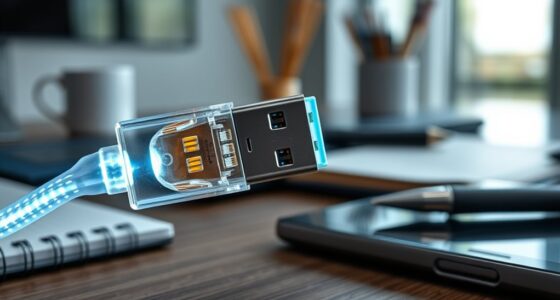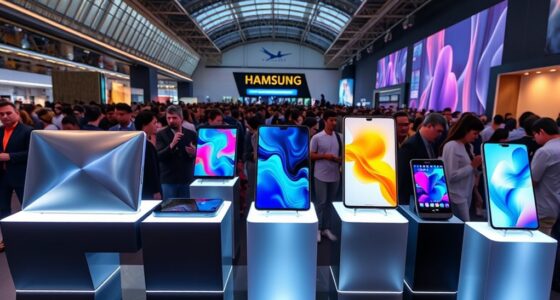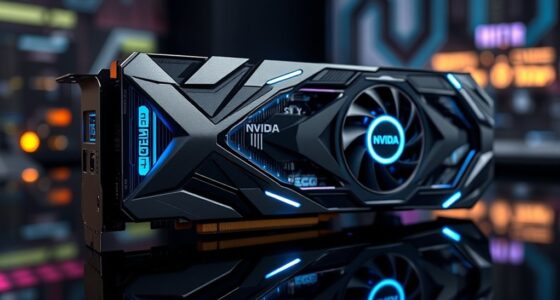If you’re wondering whether to upgrade from HDMI 2.1 to 2.2, consider your current setup and future needs. HDMI 2.2 doubles bandwidth, supporting higher resolutions like 12K and faster refresh rates up to 240Hz, ideal for high-end gaming and professional use. It also improves audio-visual sync and stability. If you want the latest tech, certified cables, and maximum performance, upgrading makes sense. To discover more about the differences and whether it’s right for you, stay tuned.
Key Takeaways
- HDMI 2.2 doubles bandwidth to 96 Gbps, supporting higher resolutions and faster refresh rates than HDMI 2.1.
- HDMI 2.2 is future-proof, enabling 12K at 120Hz and 240Hz refresh rates, ideal for high-end gaming and professional use.
- Certified HDMI cables are essential to fully utilize HDMI 2.2’s capabilities; older or uncertified cables may limit performance.
- HDMI 2.1 is sufficient for most current 4K and 8K content, but HDMI 2.2 offers enhanced performance for advanced displays.
- Upgrading depends on your device resolution, refresh rate needs, and whether you want the latest features and higher data transfer speeds.
Comparing Bandwidth and Data Transmission Capabilities
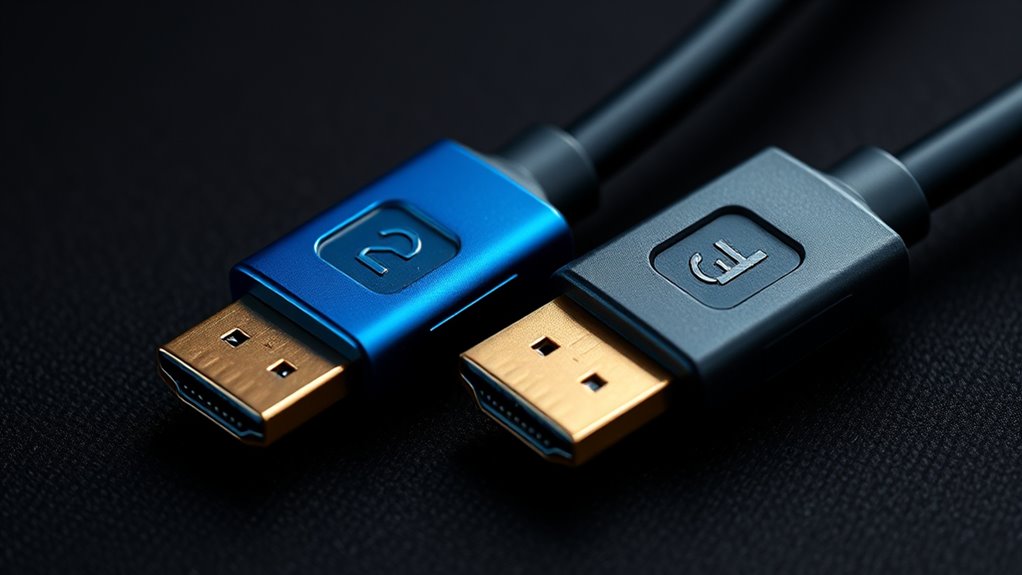
HDMI 2.2 considerably outperforms HDMI 2.1 regarding bandwidth and data transmission capabilities, making it better suited for high-resolution, high-refresh-rate content. HDMI 2.1 offers a maximum bandwidth of 48 Gbps, but HDMI 2.2 doubles that to 96 Gbps, allowing for faster data transfer. This significant boost enables the transmission of larger data volumes in less time, which is essential for handling uncompressed 8K RGB and future 16K formats. You’ll need compatible cables to fully utilize HDMI 2.2’s capabilities, as older cables may not support its higher bandwidth. With greater data capacity, HDMI 2.2 positions itself ahead of rivals like DisplayPort 2.1a, ensuring smoother, more detailed visuals for demanding multimedia applications. bandwidth and data transmission are critical factors in supporting advanced multimedia content, and understanding technical specifications helps consumers make informed upgrades.
Resolution and Refresh Rate Advancements
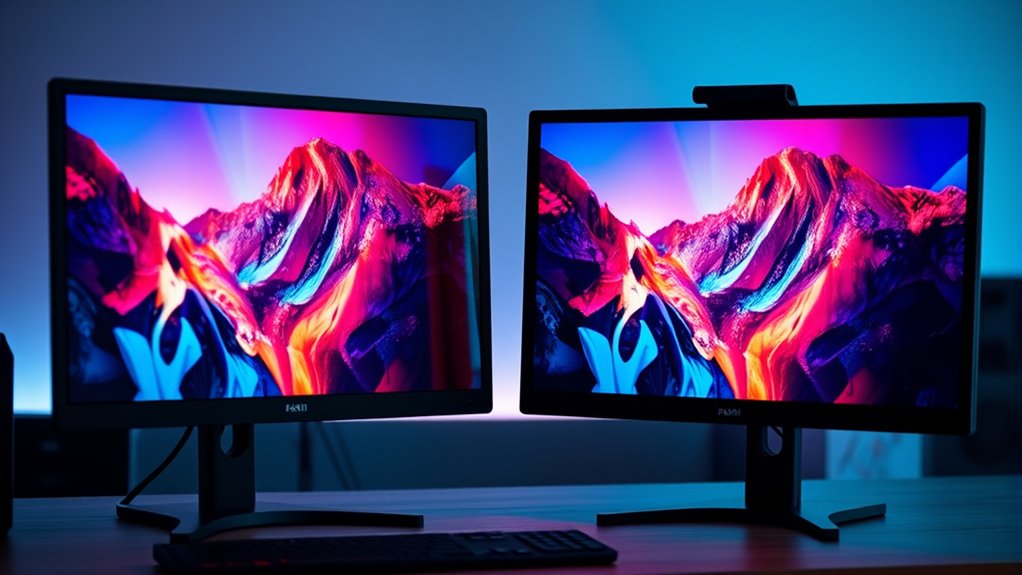
HDMI 2.2 offers considerably higher resolutions and faster refresh rates than HDMI 2.1, pushing the limits of display technology. You’ll see smoother motion, richer detail, and more future-ready capabilities with these advancements. As a result, your gaming, media, and professional work benefit from sharper images and more responsive performance. Additionally, color accuracy improvements supported by HDMI 2.2 can significantly enhance the visual experience by delivering more precise and vibrant colors.
Higher Resolution Support
Have you ever wondered how newer HDMI versions support higher resolutions and faster refresh rates? HDMI 2.1 supports up to 4K at 120Hz and 8K at 60Hz, while HDMI 2.2 pushes these limits further—supporting 4K up to 480Hz, 8K at 240Hz, and even 12K at 120Hz. With a maximum bandwidth of 48 Gbit/s, HDMI 2.1 handles high-res content efficiently, but HDMI 2.2 doubles that to 96 Gbit/s, enabling even more detailed images without compression. This increased data capacity means you can enjoy sharper, more immersive visuals on future displays. It also ensures compatibility with evolving high-resolution standards, making your setup more future-proof and adaptable to technological advancements. Additionally, the high-bandwidth transmission allows for smoother gameplay and seamless video streaming experiences, and the enhanced capabilities support advanced sound design features in multimedia setups. The increased bandwidth also facilitates higher frame rates, which are essential for competitive gaming and cinematic quality, supporting advanced display technologies that are continually emerging.
Faster Refresh Rates
The increase in bandwidth with HDMI 2.2 enables much higher refresh rates, allowing for smoother motion and more detailed images. With 96 Gbps, HDMI 2.2 supports 4K at up to 480 Hz and 8K at 240 Hz, far surpassing HDMI 2.1’s limits. This means you’ll experience less motion blur, sharper visuals, and more responsive gameplay, especially in fast-paced scenes. Higher refresh rates also reduce input lag and improve overall responsiveness, making your gaming, streaming, or professional work more seamless. To take full advantage, you’ll need certified cables capable of handling the increased data transfer. Additionally, understanding vertical storage solutions can help you optimize your setup for the best performance and organization. Overall, HDMI 2.2’s faster refresh rates ensure a smoother, more immersive viewing experience, future-proofing your setup for upcoming high-performance display technologies.
Future Display Capabilities
With the increased bandwidth of HDMI 2.2, future display technologies will push the boundaries of resolution and refresh rates far beyond current standards. You’ll be able to enjoy uncompressed 4K at 240Hz and 8K at 120Hz, offering smoother visuals with less latency. HDMI 2.2 also supports new formats via Display Stream Compression (DSC), enabling 8K at 240Hz, 10K at 120Hz, and even 12K at 120Hz. This means future displays could reach 16K at 60fps, accommodating advanced VR, AR, and professional applications. Higher color fidelity, full chroma 4:4:4 at high resolutions, and improved HDR are also supported, ensuring superior image quality. To access these capabilities, you’ll need compatible hardware, cables, and devices designed to handle the increased data transfer requirements.
Enhancements in Audio-Video Synchronization
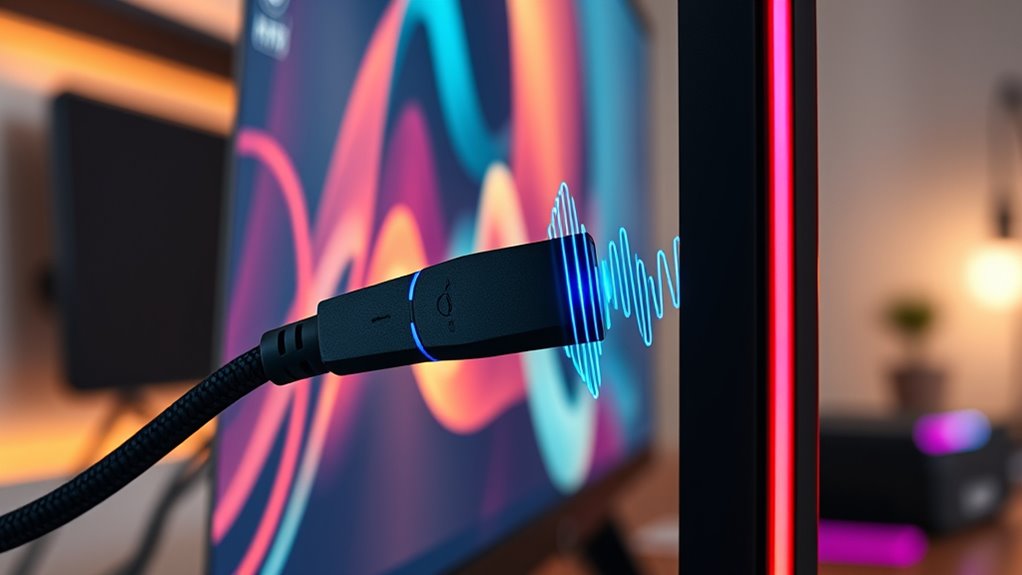
Enhancements in audio-video synchronization in HDMI 2.2 markedly improve your viewing and gaming experiences by ensuring that sound and images stay perfectly aligned. This is especially crucial in home theater setups and fast-paced gaming, where real-time sync is critical. This protocol also supports latency reduction, which enhances the responsiveness of interactive content. Additionally, the increased bandwidth of 96 Gbps allows for high-resolution content to be transmitted more efficiently, reducing lag and buffering issues. A new feature called timing accuracy further refines synchronization, ensuring even more precise audio-video matching. The implementation of testing tools and best practices guarantees the reliability of these improvements. With bandwidth increased to 96 Gbps, HDMI 2.2 handles high-resolution and high-refresh-rate content more smoothly, maintaining tight sync without lag. It also supports higher resolutions like 8K at 240Hz, ensuring seamless AV performance at demanding frame rates. These improvements lead to more stable HDR processing, fewer artifacts, and consistent audio timing, delivering a richer, more immersive experience across all your devices. Furthermore, standardization efforts ensure consistent performance across various devices and brands, making your upgrade more future-proof.
Cable Compatibility and Future-Proofing

To fully benefit from HDMI 2.2’s advanced features, you need certified cables that support its higher bandwidth. Using non-certified or older cables can limit performance and cause compatibility issues with new devices. Investing in certified cables now helps guarantee your setup remains future-proof as technology continues to evolve. Additionally, ensuring your cables are high quality can prevent signal degradation and improve overall viewing experience.
Certified Cable Requirements
Certified HDMI cables must meet strict standards set by the HDMI Forum to guarantee compatibility and future-proofing. These cables undergo rigorous testing at HDMI Authorized Testing Centers (ATCs) to verify they support HDMI 2.1 features like 4K, 8K video, VRR, eARC, and bandwidth requirements. Certification confirms the cables meet electromagnetic interference (EMI) limits, reducing wireless interference and ensuring data integrity. Certified cables display a hologram and QR code with the Ultra High Speed HDMI logo, verifying authenticity and preventing counterfeits. The certification process guarantees backward compatibility with HDMI 2.0 devices, allowing seamless integration. As the standards evolve, certified cables are designed to support higher bandwidths and advanced features, safeguarding your investment and ensuring your setup is ready for future technologies.
Ensuring Long-Term Compatibility
Ensuring long-term compatibility with HDMI standards depends heavily on choosing the right cables and understanding their capabilities. HDMI 2.2 requires Ultra96 HDMI cables to support its doubled bandwidth of 96 Gbps, surpassing HDMI 2.1’s 48 Gbps. While existing Ultra High Speed cables are backward compatible, they may not reliably transmit higher resolutions and refresh rates like 8K@240Hz without signal degradation. Cable length and quality are critical, especially at high data rates, so longer runs may need certified Ultra96 cables to maintain performance. Future HDMI 2.2 devices will likely mandate these certified cables to guarantee full compatibility. To future-proof your setup, verify cable labels and certifications, ensuring your cables meet the increased bandwidth demands and support upcoming display technologies.
Market Availability and Adoption Timeline

Although HDMI 2.2 was officially announced at CES 2025, its availability in the market is expected to be gradual, mainly targeting high-end electronics at first. The release window is projected for late 2025 or early 2026, with premium devices like gaming monitors and professional AV equipment leading the way. Broader consumer adoption will take longer, likely expanding throughout 2026 as more TVs, monitors, and AV receivers become compatible. Existing HDMI 2.1 devices will continue to serve most needs, with manufacturers producing both standards during the transition. The rollout depends heavily on demand for higher resolutions and refresh rates, as well as the market demand for advanced features. New Ultra96 cables, certified for 96 Gbps, are expected later in 2025, supporting the standard’s full potential. Additionally, the development of high-bandwidth cables will be crucial to fully utilize HDMI 2.2’s capabilities, especially as hardware compatibility improves across different devices. As consumer interest and technological advancements progress, the adoption of HDMI 2.2 is likely to accelerate, making it more accessible to a wider audience. Moreover, the integration of natural materials in device construction could influence future design standards and compatibility.
Which Standard Fits Your Needs?
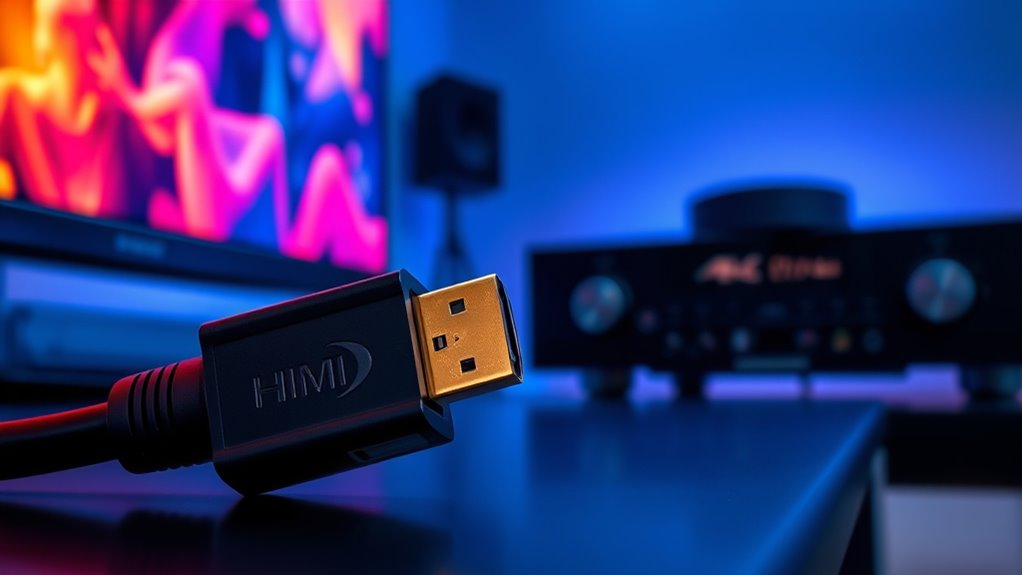
Wondering which HDMI standard best suits your needs? Here’s how to decide:
- If you primarily watch 4K content and game casually, HDMI 2.1 with 8K@60Hz or 4K@120Hz will meet your needs.
- For high-end gaming, professional video editing, or future-proofing, HDMI 2.2 with support for 8K@240Hz and 12K@120Hz offers superior resolution and refresh rates.
- If you prioritize advanced audio-visual sync and a seamless home theater experience, HDMI 2.2’s LIP protocol provides better accuracy.
- When considering cable compatibility and equipment, verify you’re using certified Ultra High Speed HDMI cables to attain peak performance for your chosen standard.
Choose based on your resolution demands, refresh rate preferences, and setup complexity.
Frequently Asked Questions
Will HDMI 2.2 Be Backward Compatible With Existing HDMI 2.1 Devices?
You wonder if HDMI 2.2 will be backward compatible with your existing HDMI 2.1 devices. The good news is, yes, it is fully backward compatible. You can connect HDMI 2.2 cables and ports to your current HDMI 2.1 or older devices without issues. The connection will work at your device’s maximum supported speed, ensuring no functionality is lost, and you won’t need to replace your existing equipment immediately.
How Do HDMI 2.2 Cables Differ From HDMI 2.1 Cables in Quality?
HDMI 2.2 cables differ from HDMI 2.1 cables mainly in bandwidth capacity and certification standards. With support up to 96 Gbps, HDMI 2.2 cables, like the Ultra96 HDMI Cable, provide higher data transfer rates, ensuring better image quality and lower interference. They’re designed to handle ultra-high resolutions and refresh rates, making them more reliable for demanding applications like 8K and 12K video streaming, gaming, and professional use.
Are There Any Cost Differences Between HDMI 2.1 and HDMI 2.2 Setups?
Did you know HDMI 2.2 cables can cost up to twice as much as HDMI 2.1 cables? The price difference mainly stems from the advanced technology and certification standards of HDMI 2.2, supporting higher bandwidths for future 8K and 10K displays. Upgrading your setup to HDMI 2.2 might mean higher costs for cables, devices, and installation, especially if you’re aiming for the latest high-performance features now.
Can HDMI 2.2 Improve Gaming Experiences on Current Consoles?
You might wonder if HDMI 2.2 can boost your current gaming experience. Right now, it doesn’t offer noticeable improvements over HDMI 2.1, which already supports high resolutions, fast refresh rates, and low latency features. Upgrading to HDMI 2.2 won’t give you better graphics or responsiveness today. Stick with your current HDMI 2.1 setup, as it’s fully capable of handling your current console gaming needs without any issues.
What Are the Main Benefits of HDMI 2.2 for Professional Content Creators?
The main benefits of HDMI 2.2 for professional content creators include support for ultra-high resolutions like 8K and 12K at high frame rates, which guarantees crisp, detailed visuals. It also offers increased bandwidth for richer color depth and HDR, improving image quality. Plus, it enables better synchronization of audio and video, reduces latency, and supports future-proof workflows, making it easier to handle emerging tech and complex multi-display setups.
Conclusion
So, do you really need to upgrade to HDMI 2.1? Think of it like choosing a new gear—sometimes, the latest isn’t necessary unless you crave that extra speed and clarity. If your current setup satisfies your streaming, gaming, or home theater needs, stick with what you have. But if you’re chasing future-proofing, it’s like planting a seed—embrace HDMI 2.1 now, and watch your entertainment grow brighter and bolder tomorrow.



